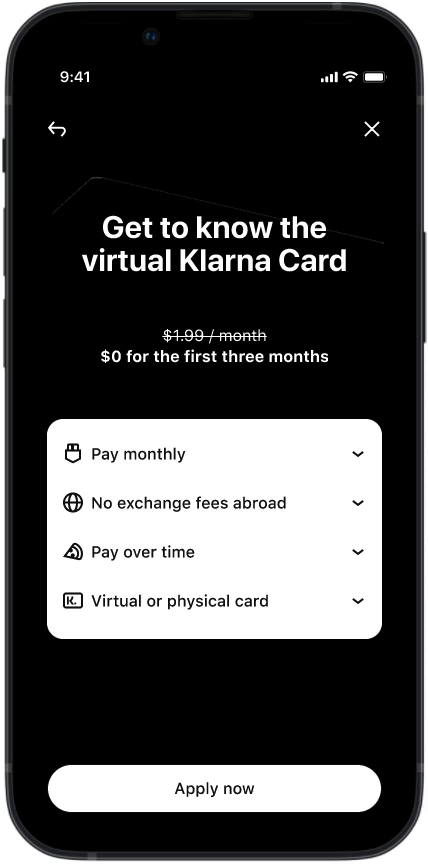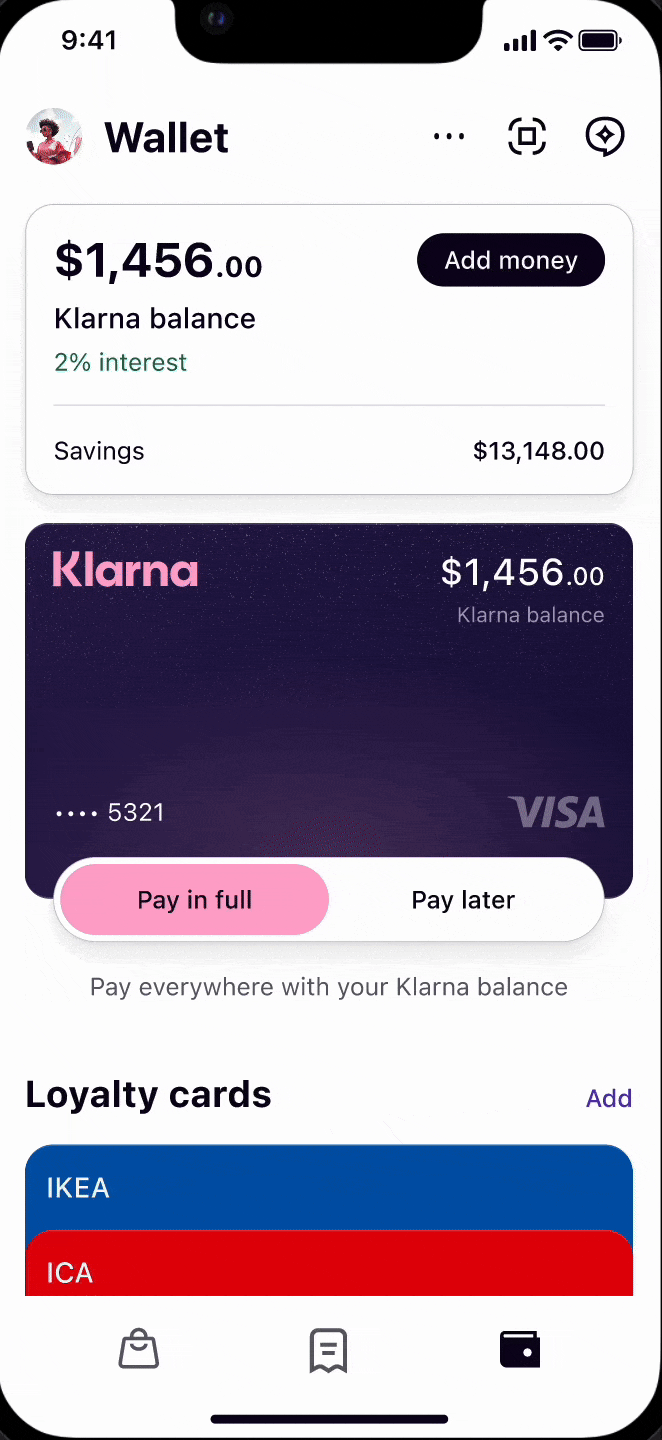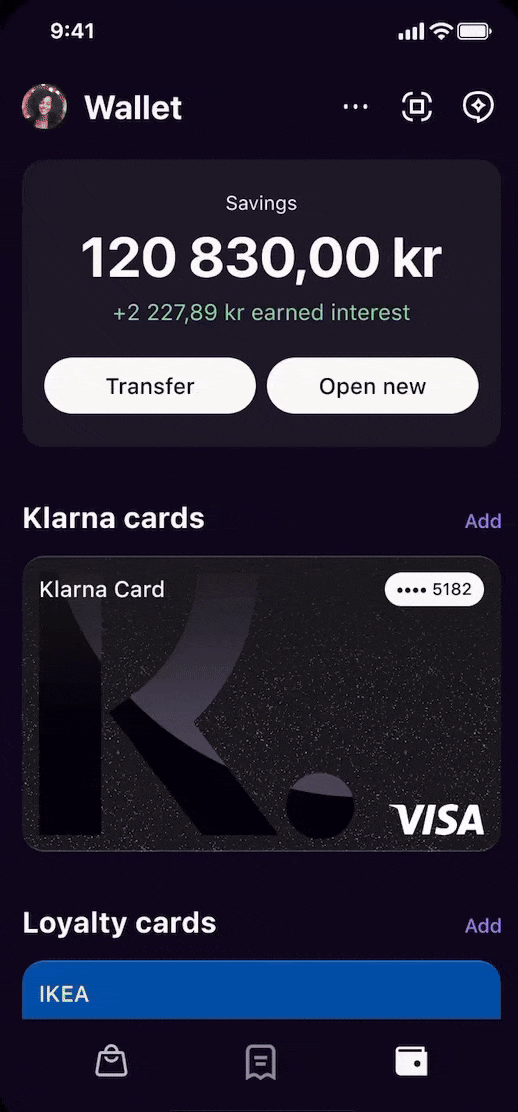Klarna
Role
Design Director, Card, Banking & Wallet
Year
October 2021 - July 2025
Summary
As Design Director at Klarna, I was recognized for setting a high standard for design quality, mentoring and growing top-tier talent, and shaping the vision across a diverse portfolio of products. I combined strategic leadership with hands-on execution, ensuring that design played a central role in delivering cohesive, impactful experiences at scale.
Highlights
Oversaw the delivery and launch of the improved Klarna Card in both the US and UK markets, with enhanced user experience and feature adoption. This contributed to substantial growth in Klarna Card users, with active cardholders increasing by over 40% in the US and 35% in the UK within the first year post-launch.
Led the release of Klarna Balance, a new financial product expanding Klarna’s portfolio to include both pay-now and pay-later options. This diversification enhanced Klarna’s market offering and customer reach, contributing to rapid adoption with Klarna Balance users growing by over 50% within the first six months of launch
As design director I led initiatives that fueled double-digit year-over-year growth in active users and transaction volumes for Klarna’s financial services. By expanding and enhancing the core financial products, I helped drive increased engagement, and strengthened Klarna’s position as a leading fintech platform.
Klarna Card
💳
Klarna Card 💳
Klarna Card
Role
Design Director & Workstream Lead
Product / Market
Klarna Card 🇬🇧🇺🇸
Year
Q3 2021 - Q2 2024
Team
Simone Marcarino: lead designer, Giuliana Menezes: product designer, Natalia Parodi-Picanco: user research, Michelle Tucker: content design
Summary
When I joined Klarna, both the UK and US Klarna Cards had been paused for new signups due to poor underwriting practices and a confusing user experience that contributed to customers unintentionally accruing debt. We needed to reposition the brand as a more flexible and transparent financial partner, while simplifying the card experience to increase trust and usage. I led the end-to-end redesign of the Klarna Card in the UK—and later partnered on the relaunch of the Klarna Card in the US in 2024.
My Role
I was designated as design workstream lead for the Klarna Card UK relaunch. I worked cross-functionally with product, risk, compliance, and engineering teams to redefine Klarna’s approach to credit products. I had an amazing team of designers who executed the end-to-end design. Our focus was clear: build a card experience rooted in transparency, control, and financial well-being—while elevating the craft with an emphasis on simplicity.
Process
Research
To kick off the Klarna Card UK and Klarna Card US redesign, we traveled to London and Chicago respectively to conduct in-person user research. Using the RITE method (Rapid Iterative Testing and Evaluation), we tested and iterated prototypes over four days, observing up to six participants per day. This fast-paced, hands-on approach allowed us to identify usability issues and uncover deeper insights early in the design process.
Key Insight
One of our biggest findings in the UK was that the card’s most compelling benefits—like no foreign transaction fees—were buried in the fine print. When we restructured the onboarding flow to lead with that benefit, participants immediately expressed stronger interest and intent to sign up. This became a pivotal messaging shift in the product’s positioning.
In the U.S., we restructured our value proposition to lead with the strongest user benefits. Through testing, we found that a more concise signup experience—with a streamlined layout and sharper, more compelling messaging—reduced confusion and significantly increased conversion. By moving to a single-page onboarding flow with collapsible half-panels instead of a multi-step journey, we made the experience faster, clearer, and more effective at driving signups.
Cross-Product Collaboration
While we were designing both card experiences, the Klarna app’s broader navigation system was also evolving. Our team tested early versions of the new app navigation and design, providing actionable feedback to the Design Systems team. Our input helped streamline the structure, resulting in a simpler and more intuitive experience across the entire app.
Regulatory Alignment
After validating the core experience, we partnered closely with legal and marketing to ensure our designs met the requirements for launching a fully regulated credit card in the UK. This included everything from compliant language to visual clarity in key disclosures and repayment terms.
Impact
30%
Revenue increase from the card in the UK
55%
Decrease in debt collection referrals in the UK
32%
Year of year growth of the card in the US
5%
Increase in conversion attributed to the improved onboarding experience in the US
What’s Next
Klarna Debit Flex Card
In Q3 2023, Klarna kicked off a strategic initiative to unify its debit and credit offerings into a single, flexible product: a Klarna Card that allows users to pay from their Klarna balance, a connected bank account, or split purchases into Pay in 30 or installments.
As design lead, I partnered closely with a small, focused team of designers and worked directly with Klarna’s CPO to bring this ambitious vision to life. Our goal was to design a seamless, intuitive experience that merged the convenience of a debit card with the flexibility of BNPL—without sacrificing clarity or control for the user.
In December 2023, we ran a focused one-day user research session to test early concepts of Klarna’s unified debit-credit card. Initial feedback was clear: the experience was too complex, and users struggled to understand how and when to use different payment options.
This insight prompted a cross-functional collaboration with marketing, content design, and legal to refine the concept into something more intuitive and transparent. We also benchmarked leading U.S. BNPL providers—like Affirm—to understand how they approached similar challenges.
Working in close partnership with Klarna’s Chief Product Officer, we held near-daily design and product sessions to sketch complex purchase flows, stress-test user journeys, and define a simpler, more flexible experience. The result is a product that offers real-time flexibility—allowing consumers to either pay now (without impacting their credit score) or defer payment through Klarna’s trusted Pay Later options.
The outcome is a card that’s not only user-friendly, but also fully aligned with Klarna’s mission to provide smarter, more transparent financial tools.
In June 2025, Klarna launched a limited pilot of the hybrid Visa card in the U.S., with over 5 million consumers joining the waitlist—a strong signal of market demand and early validation of the product direction. Klarna Debit Flex Card.
EARLY DEBIT FLEX CARD DESIGN
SIMPLIFIED DESIGN
Klarna balance
🏦
Klarna balance 🏦
Klarna balance
Role
Design Director & Workstream Lead
Product / Market
Klarna balance 🇺🇸🇪🇺
Year
Q1 2023 - Q2 2024
Team
Mercedes Hermann: lead designer, Marta Forastieri: product designer, Borys Baklanov: product designer, Natalia Parodi-Picanco: user research, Michelle Tucker: content design
Summary
As Klarna looked to expand beyond BNPL and enter the Pay Now space, the challenge was twofold: scaling a successful legacy feature from Germany (Klarna Bank) to new markets, and repositioning Klarna in the minds of U.S. consumers who primarily associated the brand with deferred payments.
In the U.S., this was particularly complex. Regulatory hurdles required Klarna to partner with a local bank, and the competitive landscape was crowded—with players like CashApp, Venmo, and traditional banks dominating the Pay Now and debit spaces
My Role
I was the designated workstream design lead for the entirety of the Klarna balance project. I worked cross-functionally with product, risk, compliance, and engineering teams to redefine Klarna’s approach to credit products. I had an amazing team of designers who executed the end-to-end design. Our focus was clear: build a card experience rooted in transparency, control, and financial well-being—while elevating the craft with an emphasis on simplicity.
Process
Research
We kicked off the project with in-person user research in Chicago, using the RITE (Rapid Iterative Testing and Evaluation) method to test early concepts and visual directions. Initially, users struggled to grasp the idea of using Klarna for Pay Now. But once the value proposition clicked—particularly the ability to pay immediately without impacting credit scores—their interest grew rapidly.
Key Insight
We iterated on visual treatments of the Klarna Balance to improve clarity and appeal. Our research showed that allocating space for short explanatory copy and clearly communicating perks like cashback or interest-earning balancessignificantly boosted user understanding and intent to sign up.
This insight directly shaped the final design and positioning of Klarna Balance as a transparent, flexible financial option that could compete head-on in the U.S. debit space—while helping evolve Klarna into a full-service financial brand.
Global Complexity
We wanted Klarna Balance to be a scalable, unified product across all markets. That meant navigating transitions in existing Klarna Bank markets:
In Germany, we needed to migrate existing users from the legacy Klarna Bank account to Klarna Balance without disrupting trust or functionality.
In Sweden, Klarna offered a Savings account but not a transactional one—so we needed to merge Klarna Balance with Savings, creating a new hybrid experience while preserving user confidence.
I led the design of the end-to-end migration flow, partnering closely with the CPO, legal, and content design teams. Our goal was to reframe Klarna Balance not just as a replacement, but as a clear upgrade—with added value, improved control, and enhanced transparency. We were clearly successful with 99% repeat usage after 12 months.
Impact
1.6 million
Users onboarded in the first three months
$1 billion
Consumer deposits grew in 2024 with Klarna balance
15 markets
Launched in 2024 with Klarna balance
Design Director
✨
Design Director ✨
Design Director
Role
Design Director
Product / Market
Card, Banking & Wallet
Year
October 2021 - July 2025
Team
Simone Marcarino; senior design lead, Giuliana Menezes: product designer, Marta Forastieri: product designer, Melanie Löff-Bird: product designer, Tim Plummer: design lead, Borys Baklanov: product designer, Tracey Tan: senior design lead, Maria Heer: design lead, Stav Rosenthal: product designer, Paya Do: design lead, Sharon Broes: product designer, Joachim Chevry: senior design lead, Noukka Signe: product designer, Kaili Chang: product designer, Christian Hoffman: product designer, Hande Demeritas: product designer, Jessika Koh: product designer, Ola Trytek: user researcher, Natalia Parodi-Picanco: user research, Michelle Tucker: content design, Alex Keller: content designer
Summary
From 2021 to 2025, I was the Design Director for the Card, Banking, and Wallet domains at Klarna. For the first year of my tenure, I also led the Customer Service design domain, overseeing a broad and complex portfolio of consumer-facing products. I managed 12–15 designers at a time—including design leads and managers—and was responsible for as many as 25 designers across multiple domains.
My Role
I reported directly to the Chief Product Officer, and together with two other design directors, oversaw the entire Klarna design organization. We worked closely to define and scale Klarna’s design practice—shaping ways of working, introducing process improvements, and running key rituals like design all-hands, crits, and onboarding. Our focus was on creating a strong, consistent design culture across domains while supporting autonomy and depth within individual teams.
The teams I led consistently had the highest designer satisfaction and retention rates at Klarna. I was proud to support the growth of my team—promoting 3–5 designers annually and advocating for pay increases and recognition across levels. Through multiple company-wide reorganizations, I prioritized transparency, psychological safety, and continuity. My goal was always to create an environment where designers could thrive creatively, even during periods of change.
Achievements
Leading through change
Shortly after I joined, Klarna experienced its first major company-wide layoff, impacting thousands across the organization. While only a few designers under my remit were affected, the atmosphere was one of deep uncertainty. I worked closely with our product leadership to restructure and reorganize the Card & Banking domain, ensuring that teams remained focused, aligned, and supported through the transition.
In the wake of this disruption, my priority was to create a psychologically safe space for designers—a place where creativity could continue to thrive despite the external instability. I leaned heavily into clear communication, transparency, and empathy, helping designers understand not only what was happening across the business but how it affected their teams, their work, and their future.
Throughout my tenure, Klarna went through multiple additional reorgs and strategy shifts, with teams frequently moving in and out of the domain. In every case, I led with a people-first mindset—anchoring teams in trust, context, and clarity to help them stay grounded and focused.
Design Organization
When I joined Klarna, the Card & Banking domain was structured around five decentralized product groups, each led by a design manager and composed of several teams. Designers were typically embedded one-to-one with product managers, working within narrow scopes and often spending their time on minor iterations or engineering handoffs. This setup led to three key challenges: designers working in isolation, inconsistent design quality across products, and uneven workloads—with intense spikes of demand followed by periods of low engagement.
These structural issues created an environment where designers struggled to find creative momentum or see the broader impact of their work. It also led to fragmented user experiences across our products. To address this, I led a restructuring effort in close collaboration with cross-functional leadership, shifting the organization toward a more centralized model.
In this new model, designers were still aligned with product groups, but each group had a dedicated design lead working directly with its product director. Rather than being siloed, designers collaborated more fluidly across projects within their group. This enabled better knowledge sharing, stronger design quality, and more flexible resource allocation—ensuring no one was overwhelmed or underutilized.
The change had a meaningful impact. Designers gained broader ownership, peer collaboration increased, and design cohesion across the product suite improved. Most importantly, designer satisfaction rose significantly—driven by the sense of support, increased scope, and clear contributions to outcomes. It was a foundational shift that helped elevate the quality, velocity, and morale of the entire design organization.
Hands On Design
During my time at Klarna, I served not only as a hands-on design director but also as the design workstream lead for several of the company’s most high-priority product initiatives. These included the Klarna Card UK relaunch, the introduction of Klarna Balance, the 2024 Klarna app redesign, and the new combined debit/credit Klarna Card for the U.S. market.
As design lead for these workstreams, I was responsible for setting the design and product vision, defining the structure of the initiative, and aligning teams across multiple disciplines. I worked closely with other leads to allocate work, ensure consistency across touchpoints, and guide execution from concept through delivery. These were high-stakes launches, and each required tight collaboration with the Chief Product Officer, as well as regular iteration across product, legal, marketing, and engineering.
In every case, I relied on qualitative insights and quantitative data to inform direction—from the strategic foundation to interaction-level details. This ensured the work was both user-centered and business-aligned.
Each of these initiatives has now launched successfully, contributing significantly to Klarna’s overall growth and deepening customer engagement across Card, Banking, and Wallet. In Q3 2024 Klarna reported a net profit of SEK 216 million (~$20 million), its first profitable quarter since 2019. This was fueled by increased payment volumes—especially in the U.S.—and efficiency gains from new financial products like Klarna Balance and the new Klarna Cards.
Impact
216 million SEK
Klarna’s net profit in Q3 2024, Klarna’s first profitable quarter since 2019 fueled by increased payment volumes and gains from new financial products like Klarna balance and Klarna Card.




